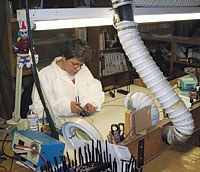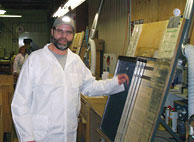DISCOVERY AND EARLY YEARS
The first electrically enhanced air filters date back to 1930. They combined elements of both passive and electronic filtration.As with most high-efficiency filtration products, polarized media has its roots in industrial applications. Although there have been a number of different configurations since then, all of them are based on charging, or polarizing fibers in a filter and particles in the air to generate an electric force between the fibers and particles.
The principle has been around for many decades, however, it is only in recent years that the technology has been fully understood thereby maximizing its effectiveness and providing consistent, reliable performance.
In 1982, two professors from Carleton University in Ottawa designed a residential application that provided a simple means of replacing dirty media. They started Engineering Dynamics Ltd. (EDL) and began manufacturing 1-inch and 2-inch polarized-media EACs, room console units, and overhead ceiling-mount units. Since then, subsequent patents and refinements have created discernable differences in the product designs and features.
The original EDL was acquired in 1997 by Environmental Dynamics Group, now known as Dynamic Air Quality Solutions, the manufacturer of Dynamic air cleaners. Initially the company's focus was residential, but there was a clear need for improved air quality in commercial and industrial applications. This resulted in a focus on technology enhancements, new configurations, and a complete line of commercial products.

THE POLARIZING DIFFERENCE
"Polarization is very different from ionization," explained Duke Wiser, president of Dynamic Air Quality Solutions. "A polarized field does not produce any ozone. Also, polarized molecules are not charged and therefore less apt to collect where you don't want them to."Ionized particles have either a positive or negative charge and are attracted to oppositely charged surfaces, such as collector plates in precipitating air cleaners," Wiser said. "Charged particles can also collect on walls, ductwork, and clothes."
Polarized-media air cleaners tend to do an excellent job of removing submicron (less than 1 micron in size) particles without efficiency loss. The carbon center screens used in Dynamic air cleaners, for example, also trap odors and volatile organic compounds (VOCs).
Polarization air cleaner effectiveness is best measured by assessing particle levels in a home or building over time. Part of the reason for this is a process called agglomeration. Trapped particles in the air cleaner become polarized, as do any particles that pass through the air cleaner.
Through agglomeration, polarized particles bond with other polarized particles as they collide in the air. As they increase in size, they are collected. This enables the air cleaner to capture very small, submicron particles that tend to suspend in the air rather than move in the airstream.
"Any air cleaning system's effectiveness will be, in part, determined by the air change rates, airflow patterns, and contaminant generation rates," said Wiser.
"Typically in a house we see particle reductions of 70 percent to 90 percent, but because of the low air change rates in a home, it may take a few days.
"In a casino, on the other hand, even though the contaminant level and generation rates are much higher, the air change rates are more than 10 times higher than they are in a house. Significant reductions in both particles and VOCs are almost immediate."
Laser particle counters have confirmed this phenomenon. Over a time period of several days, a reduction in particles under 0.3 microns in size would be observed first. As the smaller particles form larger particles, there is a spike in the number of larger particles. Then the total particle count drops off significantly.

TESTING CHALLENGES
The minimum efficiency reporting value (MERV) is the most commonly used measurement for filters. MERV is based on a single pass and is used for measuring passive mechanical filters.Appropriate testing "is the biggest challenge for manufacturers of polarized-media air cleaners," Wiser explained.
"There is no widely accepted test protocol today that demonstrates the effectiveness of polarized media.
"Single-pass measurements don't account for loading, which is the trade-off for efficiency," said Wiser. "For mechanical filters, loading is detrimental because it increases static pressure. And although static pressure is not an issue for electronic precipitating air cleaners, they lose efficiency as plates and wires get dirty.
"So ratings like MERV do not provide a universal indication of performance under real-world conditions."

MARKET DRIVERS
Air cleaner size is the biggest benefit within the residential segment, after performance. Polarized-media air cleaners offer a high-performance air cleaner option that can be installed with minimal labor and no ductwork modifications. This makes it a sellable item when technicians are on service, repair, or maintenance calls.This is a big exception to traditional thinking that implies that the logical time to sell an air cleaner is when the indoor unit is changed out. And we know from influences outside our industry, like the recent success of room air purifiers, that a large demand exists.
Commercially, again with efficiency aside, the biggest benefit is the payback based on energy and operational cost savings. There are many costs associated with commercial filters. The lower static pressure of polarized-media air cleaners means lower energy consumption.
There are also costs associated with shipping, storing, and replacing filters. Polarized-media air cleaners load efficiently, which translates into longer maintenance intervals.
"Casinos were early adopters because of the product's effectiveness at removing tobacco smoke and odors, and casinos' ability to correlate air quality to revenue," Wiser explained. "Other recent high-profile projects include the U.S. Securities and Exchange Commission and Churchill Downs."
COMING OF AGE
Polarized-media air cleaner technology has been an important part of IAQ programs for contractors, engineers, and building maintenance staff that are responding to the heightened consumer awareness about IAQ."We estimate that polarized media sales account for 15 percent to 20 percent of the current electronic air cleaner market," said Wiser. "There are a lot of products in the burgeoning IAQ market. Polarized-media electronic air cleaners are a great value. And in the end, it's all about value."
Rob Goodfellow is director of sales and marketing, Residential Products, Dynamic Air Quality Solutions, Princeton, N.J. For more information, visit www.dynamicaqs.com.
Publication date: 01/23/2006

Report Abusive Comment